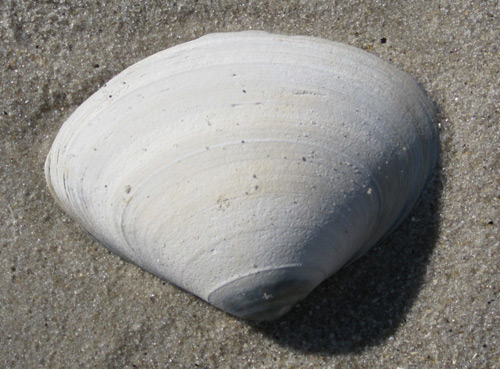surf clams are more oval or triangular than round

The distinctive and familiar shell of the surf clam.
The Atlantic Surf Clam is the largest clam on the Atlantic coast. They have a strong, triangular shaped, two-part or bivalve shell that can reach up to 6 inches across. Adult clams prefer to live in fine to medium grained sandy sediment. This may be in a nearshore location or in open waters that have suitable sandy bottoms, to a depth of 60 m. Densities do drop off at depths greater than 40 m. Adult surf clams do not move from place to place, preferring instead to stay in their sand burrows. Storms and strong currents can move them but they will rebury themselves quickly unless they become washed up onto a stable and harder to dig into beach.
This species is a plankton eating filter feeder. In turn, they are eaten by a wide range of other organisms including fish, sea stars, crustaceans and other mollusks. Each species that eats the clams have their own way of getting into the shell to access the living parts of the surf clam. The moon snail drills a small hole in the surf clam’s shell, usually near the hinge. Gulls that find a larger clam will pick them up then drop them from the air onto hard surfaces such as a dock or sidewalk to break the shell.
Surf clams account for about 70% of all clams commercially harvested in the United States. They are sold chopped and canned, and are eaten in sauces and chowders. Fishermen also use the bellies of the clam as bait for stripped bass and other fish.
For various reasons harvesting Atlantic Surf Clams for human consumption is not allowed in numerous areas (e.g., Georges Bank, the New York Harbor Estuary) where the clam is exposed to being contaminated by bacteria and other organisms that can harm humans.
Spisula solidissima spawn in mid-July through early August and from mid- October to early November. Female and male gametes are released into the water where, upon meeting, the eggs are fertilized. Spawning is temperature dependent and depending on the year, only one spawning might occur. Eggs hatch into planktonic larvae that develop a shell just before they settle into the sand, which occurs after about 3 weeks of hatching. Surf clams can become sexually mature in as little as 3 months but they will not spawn until reaching a size of 40 mm. Surf clams can live 25 years or longer. Clams in deeper, open waters typically live longer that those that live in more turbulent areas close to shore.

A line of surf clams washed up on the beach.
From the southern portion of the Gulf of St. Lawrence to Cape Hatteras, North Carolina. There are major populations of the Atlantic surf clam in Georges Bank, along the south shore of Long Island, along the coast of New Jersey and in the Delmarva Peninsula.
These shells are distinctive from the more rounded, and less common in New Jersey, Quahog shells.
